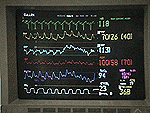Electrocardiography
What is electrocardiography?
Electrocardiography is the generation of a tracing or graph of electrical activity in the heart.
What is an electrocardiogram or electrocardiograph (ECG or EKG)?
An electrocardiogram or electrocardiograph (ECG or EKG) is the actual tracing or graph of the heart's electrical activity produced in electrocardiography.
What is an electrocardiograph machine?
An electrocardiograph machine is a device that measures and records electrical activity in the heart by the use of ECG pads placed on the chest and connected to wires, call leads. The leads are connected to a bedside monitor where the information is displayed. ECGs are usually measured in at least one view (i.e., one line on the monitor). Many doctors and nurses want more than one view, often as many as twelve views, also called leads. To measure these different views, ECG pads are placed on several parts of the body. The nurse determines where to place these pads based on the view of the heart that is desired.
Why is the patient attached to the ECG bedside monitor?
The ECG bedside monitor displays the heart rate and rhythm so that the doctor or nurse can determine whether or not the heart is beating normally.
What information does the ECG provide?
By continuously monitoring the electrical activity in the heart, the ICU staff can tell if the heart is beating too fast or slow and if the heart is following a normal or abnormal rhythm. The ECG is one of the most common monitoring devices used in the hospital. Changes in the heart rate or rhythm may be the first sign that something dangerous is developing and alert the doctor or nurse to investigate further. Frequently, the ECG indicates something is wrong long before it would be detected otherwise.
How long is an ECG used?
ECGs are used as long as the doctors and nurses believe the patient's heart is at risk or want more information about how the patient's heart is beating.
What is a normal heart rate expressed in beats per minute (pulse)?
Normal heart rates vary between 60-100 beats per minute. A lower heart rate may be normal in particularly fit people.
What is wrong when the heart rate is low or high?
Variation in heart rate, fast or slow, is very common among critically ill or injured patients. Not every fast or slow heart rate signifies danger to the patient. ICU patients are at increased risk to develop abnormal heart rates and rhythms. If the heart rate is low, the heart may not be pumping enough blood. If the heart rate is high, the heart may be working too hard or is trying to pump more blood.
Do the ECG pads or ECG monitoring hurt?
No. The adhesive on the ECG pads may pull slightly on the skin. ECG monitoring is harmless and causes no pain.
Are there any potential complications associated with ECG monitoring?
No.
ECG and heart rate (HR - 118) displayed on a bedside monitor

Close up of paper ECG tracing
